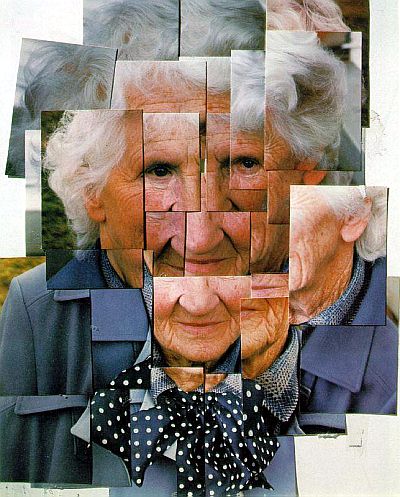Sticking with my theme of people,
I decided to focus on the photos that I had taken over the summer of family and
friends when we went on holiday to Spain. I fell in love with the beautiful
blue colours in the photographs which also influenced my decision to stick with
just the holiday photographs. In this work I decided to cut out different
shapes in the water area and I wanted the shapes to represent the movement of
the water. I feel that this piece is not entirely successful as it is very busy
and not all of the shapes are noticeable (i.e. the swirl in the bottom right
corner). I think that it would have been better if I had stuck to one type of
shape instead of trying to combine different shapes as it doesn’t allow the
composition to flow nicely.

I did a black and white photocopy
of this piece to focus on tone so that I could compare the two. I feel as
though the black and white version is not as successful as the coloured
version. There is less depth in the composition and for me it looks tacky and
seems to lose the extra detail you get from the coloured version. I love the
different blue tones of the water in the coloured piece which I feel you really
miss out on in the black and white piece and it also seems to lose its balance
without the colour.

I decided to try again doing
paper cutting but using my own drawing, as I had drawn the figure from the
photography onto white paper I decided to cut the figure out and stick her onto
black sugar paper so that there would be contrast between the figure and the
background. I also thought that by doing this it would allow the shapes cut
into the background to be more visible and it would make the composition more
balanced with white shapes and the white main subject of the piece.

This is the finished version of
the previous image. I cut out some wavy shape to try and represent the movement
of the water however I changed the drawing from the photograph I drew it from
by just focusing on the figure and not including anything else from the
photograph. I did not feel that this piece worked well as I think it was too
simplistic and I think that the lack of detail in the piece makes it hard to
appreciate it. It definitely was not as successful as the first style I tried
with my other charcoal drawing composition I think perhaps it was the black
background and the negative space that stops it from working.

As the last drawing composition
failed to work successfully I decided to try it again however this time I used Biro pen for the figure to try and get more detail into this piece as there was
a lack of it in the last composition. I kept the white background in this piece
of work to see if the style of paper-cutting would work better and decided to
then stick it over black paper to make the cut out shapes stand out and
contrast with the background. I also did less cut out shapes in the background
to try and not make the piece to overwhelming and to try and prevent the focus
moving from the figure in the piece to the black shapes seeping through the
background. I sprayed hairspray over the Biro pen drawing and moved the paper
around to try and create a water effect as she is in the water in the
photograph. However once I had sprayed the hairspray over the piece and
manipulated it around I realised that by doing this I had actually stripped
away the detail from the figure and made her almost translucent which was not
what I wanted as it meant that the figure now looked lost compared to the
shapes and contrast in the background. As this didn’t work I decided to refine
it and draw back over the figure to make the lines bolder so that the figure
would stand out again.

This is the piece once I had
refined it and as you can see the figure now stands out a lot more in
comparison to the background which has improved it greatly from before. However
I feel that the composition still doesn’t work, it could be the style in which
I have cut out the shapes but I felt as though this style actually had worked
really well when I did it on the photograph. I think again that it is the lack
of detail in the background that prevents the piece from actually working much
like the last composition I did with the charcoal drawing. When compared to the
photograph pieces and my first drawing composition I noticed that there was
detail on the majority of those pages with little blank space which I realised
seems to make the paper-cutting more successful so I decided to stop for now
with the drawing compositions and to focus more on the actual photographs.


























